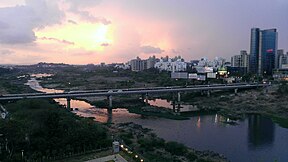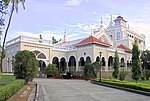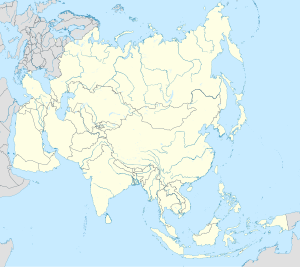
Back Pune Afrikaans पुणे ANP بونه Arabic بونه ARZ পুনে Assamese Pune AST Puna Azerbaijani پونه (شهر) AZB Пуна Bashkir Пуна (Індыя) Byelorussian
Pune (/ˈpuːnə/ POO-nə, Marathi: [ˈpuɳe] ⓘ), previously spelled in English as Poona (the official name until 1978),[15][16] is a city in Maharashtra state in the Deccan plateau in Western India. It is the administrative headquarters of the Pune district, and of Pune division. According to the 2011 Census of India, Pune is the ninth-most populous city in India with a population of 3.1 million residents within the city limits, and 7.2 million residents in the metropolitan region, making it the eight-most populous metropolitan area in India.[17] The city of Pune is part of Pune Metropolitan Region.[18] Pune is one of the largest IT hubs in India.[19][20] It is also one of the most important automobile and manufacturing hubs of India. Pune is often referred to as "Oxford of the East" because of its highly regarded educational institutions.[21][22][23] It has been ranked "the most liveable city in India" several times.[24][25]
Pune at different points in time has been ruled by the Rashtrakuta dynasty, Ahmadnagar Sultanate, the Mughals, and the Adil Shahi dynasty. In the 18th century, the city was part of the Maratha Empire, and the seat of the Peshwas, the prime ministers of the Maratha Empire.[26] Many historical landmarks like Pataleshwar caves, Shaniwarwada, Shinde Chhatri, and Vishrambaug Wada date to this era. Historical sites from different eras dot the city.
Pune has historically been a major cultural centre, with important figures like Dnyaneshwar, Shivaji, Tukaram, Baji Rao I, Balaji Baji Rao, Madhavrao I, Nana Fadnavis, Mahadev Govind Ranade, Gopal Krishna Gokhale, Mahatma Jyotirao Phule, Savitribai Phule, Gopal Ganesh Agarkar, Tarabai Shinde, Dhondo Keshav Karve, and Pandita Ramabai doing their life's work in Pune City or in an area that falls in Pune Metropolitan Region. Pune was a major centre of resistance to British Raj, with people like Gopal Krishna Gokhale, Bal Gangadhar Tilak and Vinayak Damodar Savarkar playing leading roles in struggle for Indian independence in their times.
- ^ Choudhuri, Debjani Pal (2007). Community Planning for Intervention for Victims of Domestic Violence. Kassel University Press. p. 35. ISBN 978-3-89958-346-5.
- ^ Diddee, Jaymala (2000). Pune: Queen of the Deccan. Elephant Design Pvt. Limited. ISBN 978-8187693000.
- ^ "Pune History - Origin and History of Poona India". Archived from the original on 25 February 2019. Retrieved 25 February 2019.
- ^ "Municipal Commissioner Office, Pune". Official website of the Pune Municipal Corporation. Archived from the original on 25 April 2018. Retrieved 24 April 2018.
- ^ "Vikram Kumar takes over as Pune civic body chief". 13 July 2020. Archived from the original on 31 July 2020. Retrieved 22 July 2020.
- ^ a b "Pune pips Mumbai as Maharashtra's largest city in terms of geographical area". CNBC TV18. 1 July 2021. Archived from the original on 6 March 2023. Retrieved 25 August 2022.
- ^ a b "Pune Metropolitan Region Development Authority – PMRDA". Pmrda.gov.in. Archived from the original on 26 April 2018. Retrieved 25 April 2018.
- ^ Paik, Shailaja (11 July 2014). Dalit Women's Education in Modern India: Double Discrimination. Routledge. p. 195. ISBN 9780415493000. Retrieved 25 May 2019.
- ^ Bharucha, Hoshang (25 September 2018). Glimpses of Guruprasad. Notion Press. ISBN 9781644290231. Retrieved 25 May 2019.
- ^ "PIN Code: Pune, Maharashtra, India". findpincode.net. Archived from the original on 8 April 2016. Retrieved 18 March 2016.
- ^ "Richest Cities Of India". businessworld.in/. Retrieved 13 July 2023.
- ^ "Richest Cities Of India". IndiaTimes.com. 22 October 2021. Retrieved 13 July 2023.
- ^ Chakravorty, Abhimanyu (13 April 2016). "From Gurgaon to Gurugram: 20 cities that changed their names". The Indian Express. Archived from the original on 30 April 2018. Retrieved 29 April 2018.
- ^ "52nd Report of the Commissioner for Linguistic Minorities in India" (PDF). nclm.nic.in. Ministry of Minority Affairs. Archived from the original (PDF) on 25 May 2017. Retrieved 7 December 2018.
- ^ Atre, Abhijit (30 September 2016). "What's in a name? A lot when it comes to Pune". The Times of India. Archived from the original on 16 June 2018. Retrieved 29 April 2018.
- ^ Chakravorty, Abhimanyu (13 April 2016). "From Gurgaon to Gurugram: 20 cities that changed their names". The Indian Express. Archived from the original on 30 April 2018. Retrieved 29 April 2018.
- ^ "Provisional Population Totals, Census of India 2011; Cities having population 1 lakh and above" (PDF). Office of the Registrar General & Census Commissioner, India. Archived from the original (PDF) on 7 May 2012. Retrieved 26 March 2012.
- ^ "Constituents of Urban Agglomerations having Population 1 lakh and above – Census of India 2011" (PDF). Office of the Registrar General & Census Commissioner, India. p. 34 of 61. Archived (PDF) from the original on 25 October 2017.
- ^ Kanhere, G.K. (1993). "Planning for the Pune Region". Architecture Plus Design. Vol. 10, no. 6. p. 60.
- ^ Joshi, S.R. (1996). "Mass media and cultural identity: Issues of ethnic co-existence in India". Asian Journal of Communication. Vol. 6, no. 1. pp. 124–139.
- ^ Shyam, Sarath (November 2016). "Rediscovering The Oxford Of The East | TheHigherEducationReview". The Higher Education Review (November 2016). Archived from the original on 25 May 2022. Retrieved 14 July 2022.
- ^ "The 'Oxford of the East' goes West". The Indian Express. Archived from the original on 24 April 2017. Retrieved 24 January 2017.
- ^ "Truly the Oxford of the East". Hindustan Times. Archived from the original on 2 February 2017. Retrieved 24 January 2017.
- ^ "Pune is also ranked No. 1 city in country several times in 'Ease of Living' ranking". the Times of India. 14 August 2018. Archived from the original on 13 October 2018. Retrieved 13 October 2018.
- ^ "Pune City - Cultural And Educational Capital of Maharashtra". 29 June 2021. Archived from the original on 31 July 2021. Retrieved 29 June 2021.
- ^ "Shaniwarwada was centre of Indian politics: Ninad Bedekar". Daily News and Analysis. 29 November 2011. Archived from the original on 26 January 2012. Retrieved 19 April 2012.
© MMXXIII Rich X Search. We shall prevail. All rights reserved. Rich X Search











